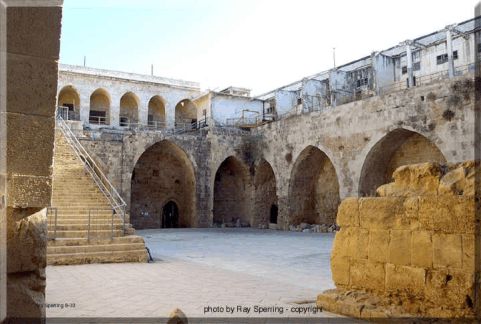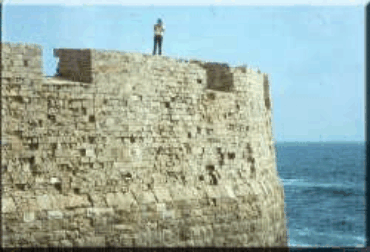 Taken from http://www.campsci.com/iguide/acco.htm
Taken from http://www.campsci.com/iguide/acco.htm The Doctrine of the City of Acco (Ptolemais)
1. In the Hebrew, Acco is ׳akkôw ( ַע) [pronounced ahk-KOH or gahk-KOH], and is transliterated Acco and Accho. Strong’s #5910 BDB #747. Josephus, Diodorus Siculus and Pliny all called it Ake (probably Άκη). The Arabs called it Akka, which was corrupted by the crusaders, who called it Acker or Acre.
2. This city is first mentioned in the Greek Septuagint in Joshua 19:30 (it is left out of the Hebrew manuscripts). Given the likelihood of the corruption of the book of Joshua in the latter half, Acco probably does belong where it is found in the Septuagint. Surprisingly enough the only mention of this city by this name in the Hebrew is our passage, Judges 1:31.
3. Location: Acco was located about 25 miles north of Dor, and about eight miles north of Mount Carmel on the Mediterranean coast. ZPEB calls its location the dividing line between the northern and southern halves of the coastal plain.
4. Both by its geographical location and by the Greek of Joshua 19:30, Acco belonged to the tribe of Asher, who was given the coast of the Mediterranean from Dor to Tyre.
5. Although this is an important city to Israel, it barely receives a footnote mention in Scripture and most of what we know about Acco is through secular history.
 Taken from http://www.campsci.com/iguide/acco.htm
Taken from http://www.campsci.com/iguide/acco.htm 6. Description: To the south there is a sandy beach which extends for quite a distance inland; in classical
tradition, this was the source of an excellent type of sand used in the manufacture of glass (Strabo, XVI. 2. 25;
Josephus, War, II.x. 2 [188–191]; Pliny, Natural History, V, 175, XXXVI, 191; Tacitus, History V. 7)...The
northern shore line is rocky and rugged down to the water’s edge. The northern cove of the Haifa bay has
served as Acco’s seaport, probably from time immemorial. There was probably a small town on the shore
even in the Israelite period, but during the Hellenistic age, the town spread from its tell to the site of the
present town (Ptolemy, V. 15. 5).
![]() The picture of the coast line in ZPEB is quite interesting; there are tall
stone walls (or, brick walls) right at the shore
dropping into the sea. It is heavily fortified
here against an attack from the sea. There is
no shore to speak of. Judging from the size
of the man in the picture, the lowest walls are
about 20 feet high and the nighest wall is
between 25 and 30 feet tall.
The picture of the coast line in ZPEB is quite interesting; there are tall
stone walls (or, brick walls) right at the shore
dropping into the sea. It is heavily fortified
here against an attack from the sea. There is
no shore to speak of. Judging from the size
of the man in the picture, the lowest walls are
about 20 feet high and the nighest wall is
between 25 and 30 feet tall.
7. www.compsci.com tell us a little about Acco:
The ancient walled city of Acco, also called
Acre, is rich in history. It is located in the
portion of land belonging to the Shevet of
Asher (Jud. 1:31) Acco is located in the
northwestern part of the country, on the
eastern shore of the Meditereanan Sea. The
city projects out into the sea and is
surrounded by water on three sides.
![]()
8. Ancient history: it appears as though this city
has existed since the Middle and Late Bronze
Ages, although we have no recording of it by
name until the 19th century b.c. It is found in the Egyptian execration texts. Thutmose III conquered it in the
middle of the 15th century b.c., in topographical maps of the 15th and 13th centuries b.c. and we find it
mentioned many times in the Amarna letters.
![]()
9. Apparently for the next several centuries, from the 15th through the 12th, Acco was gained and lost by Egypt several times.
 Another view of Acco; taken from http://www.israelholidayguide.com/acco-gallery.html
Another view of Acco; taken from http://www.israelholidayguide.com/acco-gallery.html 10. One of the reasons the city was important in the ancient world is that it was the only natural harbor along the
coast south of Phœnicia.
There were various routes
which connected it to
Galilee, the Lake of Galilee,
the Jordan valley, and
beyond.
![]()
11. Acco was, like Tyre and
Sidon, too strong for...[the
Jews] to attack and it
became...a fortress of
unusual strength, so that it
withstood many a siege,
often baffling its assailants.
![]()
12. Apparently under David, the
city came under his control,
but Solomon gave it to
Hiram, in conjunction with
about 20 other cities. Hiram
was displeased with the gift
and called the cities Cabul,
which probably means good
for nothing. Afterward, it
went under the control of
Tyre (I Kings 9:12–13
II Chron. 8:1–2). From thereon in, it was Phœnician territory. When Sennacharib, king of Assyrian, made
his punitive expedition to Palestine (701 b.c.), his forces took Acco...along with the other fortified towns
belonging to the king of Sidon at that time...On the return march from his campaign against the Arabs
(c. 660 b.c.), Ashurbanipal found it necessary to punish severely the towns of Ushu and Acco.
![]()
13. After that point, Acco remained a Phœnician-Hellenistic city. In the late 3rd or early 2nd century b.c., Ptolemy I (or the II) of Egypt named Acco, Ptolemais and a hot topic for the rabbis was whether or not the commandments found in the Bible could be applied to the residents of Ptolemaic.
14. Ptolemais played an important role in the Jews’ struggled for freedom under the Maccabees.
![]()
15. Paul, near the end of his third missionary journey, stopped there for a day while sailing from Tyre to Caesarea, because there had developed a small Christian community (Acts 21:7). This is the only mention of Ptolemais in the New Testament.
16. At this point in time, Ptolemais was a colonia of Rome, Emperor Claudius having settled a group of veterans there.
17. After the Roman period, Ptolemais took back its original name, Akka or St. Jean d’Acre, by which it is known
today. During the Crusades, it was a very flourishing maritime and commercial town.
![]()
18. Napoleon besieged the city of Acco, then called Saint Jean d'Acre, in 1799.
19. Israeli forces in the Arab-Israeli war of 1948 captured Acre [the modern English spelling of Acco]. By the
1990s its population was about three fourths Jewish and one fourth Arab. The city is a popular tourist site.
Landmarks include an ancient citadel, walled fortifications, the al-Jazzar mosque, and several churches dating
from the Crusades.
![]()
20. Today, this city is overshadowed by the prominence of the city of Haifa, which lies directly across the bay.
![]()
BCE |
|
|
c.2350 |
|
Campaign of Pepi l. |
c.1800 |
|
Mentioned in Execration texts. |
1468 |
|
Acco mentioned in city-list of Tuthmosis III. |
1400-1350 |
|
City-kingdom according to el-Amarna letters. |
1303 |
|
Campaign of Seti I passes thru Acco. |
1280 |
|
Scribe of Egypt passes thru Acco. |
701 |
|
Campaign of Sennacherib passes thru Acco. |
332 |
|
Campaign of Alexander. |
320 |
|
Ptolemy I and Nicanor occupy Acco. |
315 |
|
Antigonus, Ptolemy and Seleucus fight over Palestine. |
c.260 |
|
Acre became Ptolemais under Ptolemy II. |
246-240 |
|
Ptolemy IV and Antigonus battle for Palestine |
201 |
|
Campaign of Antiochus III passes thru Acco |
170 |
|
Antiochus IV campaign thru Acco |
163 |
|
Simon's campaign. |
150 |
|
Campaign of Jonathan; passes thru Acco. |
142 |
|
Jonathan lured to Acco and slain. |
108 |
|
City invaded by Holofernes |
69 |
|
Tigranes reached and occupied Acco. |
40 |
|
Julius Caesar passes thru Acco. |
40 |
|
Herod lands at Acco, from Rome. |
CE |
|
|
57 |
|
Mission of Paul returns to Jerusalem through Acco. |
c.65 |
|
Campaign of Gallus thru Acco |
67 |
|
Campaign of Vespasian and Titus. |
638 |
|
Resumed its name of Acco. |
c.1150 |
|
Known to Christians as St.Jean'Acre, or Acre. |
Just some abbreviated points on this city: |
The Short Doctrine of Acco |
1. Acco is first mentioned in the Greek Septuagint in Joshua 19:30 (it is left out of the Hebrew manuscripts). Given the likelihood of the corruption of the book of Joshua in the latter half, Acco probably does belong where it is found in the Septuagint. Surprisingly enough, the only mention of this city by this name in the Hebrew is our passage, Judges 1:31. 2. Location: Acco was located about 25 miles north of Dor, and about eight miles north of Mount Carmel on the Mediterranean coast. ZPEB calls its location the dividing line between the northern and southern halves of the coastal plain. 3. Both by its geographical location and by the Greek of Joshua 19:30, Acco belonged to the tribe of Asher, who was given the coast of the Mediterranean from Dor to Tyre. 4. Although this is an important city to Israel, it barely receives a footnote mention in Scripture and most of what we know about Acco is through secular history.  Taken from http://www.campsci.com/iguide/acco.htm Taken from http://www.campsci.com/iguide/acco.htm 5. Description: To the south there is a sandy beach which extends for quite a distance inland; in classical
tradition, this was the source of an excellent type of sand used in the manufacture of glass (Strabo,
XVI. 2. 25; Josephus, War, II.x. 2 [188–191]; Pliny, Natural History, V, 175, XXXVI, 191; Tacitus, History
V. 7)...The northern shore line is rocky and rugged down to the water’s edge. The northern cove of the
Haifa bay has served as Acco’s seaport, probably from time immemorial. There was probably a small town
on the shore even in the Israelite period, but during the Hellenistic age, the town spread from its tell to the
site of the present town (Ptolemy, V. 15. 5).
6. Apparently for the next several centuries, from the 15th through the 12th, Acco was gained and lost by Egypt several times. 7. Apparently under David, the city came
under his control, but Solomon gave it to
Hiram, in conjunction with about 20 other
cities. Hiram was displeased with the gift
and called the cities Cabul, which probably
means good for nothing. Afterward, it went
under the control of Tyre (I Kings 9:12–13
II Chron. 8:1–2). From thereon in, it was
Phœnician territory. When Sennacharib, king of Assyrian, made his punitive expedition to Palestine
(701 b.c.), his forces took Acco...along with the other fortified towns belonging to the king of Sidon at that
time...On the return march from his campaign against the Arabs (c. 660 b.c.), Ashurbanipal found it
necessary to punish severely the towns of Ushu and Acco.
8. After that point, Acco remained a Phœnician-Hellenistic city. In the late 3rd or early 2nd century b.c., Ptolemy I (or the II) of Egypt named Acco, Ptolemais and a hot topic for the rabbis was whether or not the commandments found in the Bible could be applied to the residents of Ptolemaic. 9. Paul, near the end of his third missionary journey, stopped there for a day while sailing from Tyre to Caesarea, because there had developed a small Christian community (Acts 21:7). This is the only mention of Ptolemais in the New Testament. |
Given that this city is mentioned only 3 times in Scripture, this is probably way more than you needed to know. However, the actual doctrine is several pages long. |